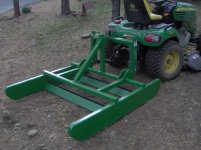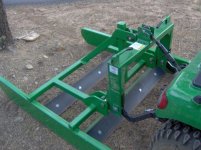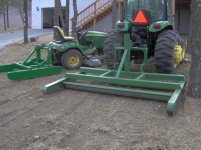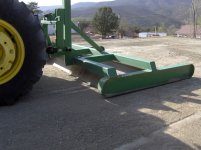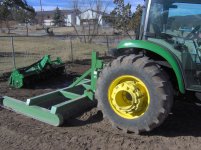FTG-05
Elite Member
- Joined
- Jan 7, 2011
- Messages
- 2,574
- Location
- TN
- Tractor
- Kubota L4330 GST w/FEL, Kubota RTV-XG850, Kubota ZD326S
I plan to design and build my own land grader so I can better maintain the one mile gravel I live on. Right now I'm using a ~700lb 6' box blade. The BB works great for about 85% of the road, but there are two-three places that turn into mudholes and I have the "wavy" road surface that's a pain to work with a BB.
My plan is 3/8" side walls using two 5"x5"x3/8" angle as the cutting blades. I'll drop the "blades" below the sidewalls by about 3/4"-1" (i.e. about the same as the BB cutter).
My question is this: Angle the blades or keep them straight (i.e. 90 degrees to the direction of travel)?
My preference is to angle them (right side forward; left side towards the back) to try and get some of the side gravel back onto the road bed, plus help with crown.
Comments, suggestions, wise cracks, all the above?
Thanks!
My plan is 3/8" side walls using two 5"x5"x3/8" angle as the cutting blades. I'll drop the "blades" below the sidewalls by about 3/4"-1" (i.e. about the same as the BB cutter).
My question is this: Angle the blades or keep them straight (i.e. 90 degrees to the direction of travel)?
My preference is to angle them (right side forward; left side towards the back) to try and get some of the side gravel back onto the road bed, plus help with crown.
Comments, suggestions, wise cracks, all the above?
Thanks!

